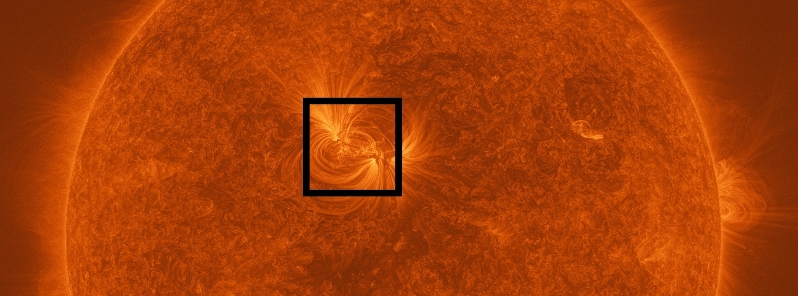New high-resolution images of the Sun unveil incredibly fine magnetic threads filled with million-degree plasma

Researchers from the University of Central Lancashire (UCLan) in the UK and NASA's Marshall Space Flight Center revealed the highest-ever resolution images of the Sun featuring its outer layer of incredibly fine magnetic threads filled with extremely hot, million-degree plasma– a sight previously unseen. The observations will help astronomers further understand what the Sun's magnetized atmosphere is made of and the way it exists.
Certain parts of the Sun's atmosphere has appeared dark or mostly empty until now. However, new images showed by the UCLan researchers and NASA have revealed that there are strands in the Sun's atmosphere that are about 500 km (311 miles) in width, filled with electrified gases inside them.
NASA's High-Resolution Coronal Imager or Hi-C took the ultra-sharp images– this unique astronomical telescope can pick out structures in the Sun's atmosphere as intricate as 70 km (44 miles) in size, or roughly 0.01 percent of the Sun.
"Until now solar astronomers have effectively been viewing our closest star in ‘standard definition’, whereas the exceptional quality of the data provided by the Hi-C telescope allows us to survey a patch of the Sun in ‘ultra-high definition’ for the first time," said Robert Walsh, professor of solar physics at UCLan and the institutional lead for the Hi-C crew.
"Think of it like this: if you are watching a football match on television in standard definition, the football pitch looks green and uniform. Watch the same game in ultra-HD and the individual blades of grass can jump out at you – and that’s what we’re able to see with the Hi-C images. We are catching sight of the constituent parts that make up the atmosphere of the star."
The research team is now planning to launch the Hi-C mission again, but this time overlapping the observations with two Sun-observing spacecraft presently collecting more information– NASA's Parker Solar Probe and ESA's Solar Orbiter.
"These new Hi-C images give us a remarkable insight into the Sun’s atmosphere. Along with ongoing missions such as Probe and SolO, this fleet of space-based instruments in the near future will reveal the Sun’s dynamic outer layer in a completely new light," said Dr. Amy Winebarger, a Hi-C principal investigator at NASA MSFC.
"This is a fascinating discovery that could better inform our understanding of the flow of energy through the layers of the Sun and eventually down to Earth itself. This is so important if we are to model and predict the behavior of our life-giving star," Dr. Tom Williams noted as well, a postdoctoral researcher at UCLan who worked on the Hi-C data.
The exact physical mechanism that is generating the hot strands is still unclear, thus, scientific debates will now focus on why they are formed and how their presence will further help understand the explosion of solar flares and solar storms that could potentially affect life on Earth.
Reference
"Is the High-Resolution Coronal Imager Resolving Coronal Strands? Results from AR 12712" – Williams, T. et al. – The Astrophysical Journal – DOI: 10.3847/1538-4357/ab6dcf
Abstract
Following the success of the first mission, the High-Resolution Coronal Imager (Hi-C) was launched for a third time (Hi-C 2.1) on 2018 May 29 from the White Sands Missile Range, NM, USA. On this occasion, 329 s of 17.2 nm data of target active region AR 12712 were captured with a cadence of ≈4 s, and a plate scale of 0farcs129 pixel−1. Using data captured by Hi-C 2.1 and co-aligned observations from SDO/AIA 17.1 nm, we investigate the widths of 49 coronal strands. We search for evidence of substructure within the strands that is not detected by AIA, and further consider whether these strands are fully resolved by Hi-C 2.1. With the aid of multi-scale Gaussian normalization, strands from a region of low emission that can only be visualized against the contrast of the darker, underlying moss are studied. A comparison is made between these low-emission strands and those from regions of higher emission within the target active region. It is found that Hi-C 2.1 can resolve individual strands as small as ≈202 km, though the more typical strand widths seen are ≈513 km. For coronal strands within the region of low emission, the most likely width is significantly narrower than the high-emission strands at ≈388 km. This places the low-emission coronal strands beneath the resolving capabilities of SDO/AIA, highlighting the need for a permanent solar observatory with the resolving power of Hi-C.
Featured image credit: UCLan








The fundamental problem of solar physics is not a lack of observational data, but rather a lack of data interpretation. Even the data collected in the 1960s is sufficient in showing the physical reality of the Sun. However, since the holy theory of the standard solar model has to be followed and all observations must not contradict it, that means all researches and advanced space instruments are waste of time and money. The author is stating that “The observations will help astronomers further understand what the Sun’s magnetized atmosphere is made of and the way it exists.” The atmosphere of the Sun cannot be understood without understanding the solar surface, which is governed by the process of fluid dynamics.